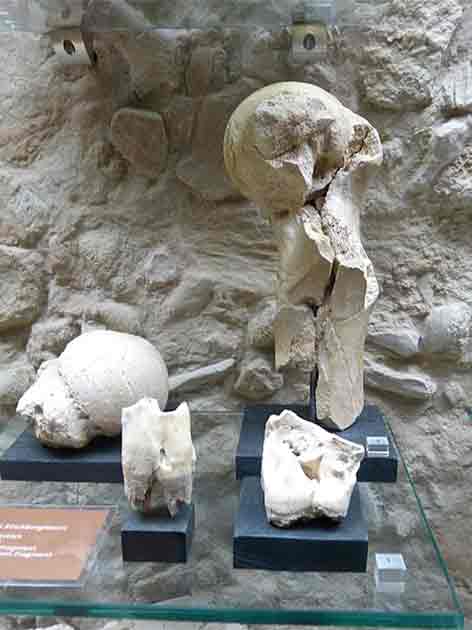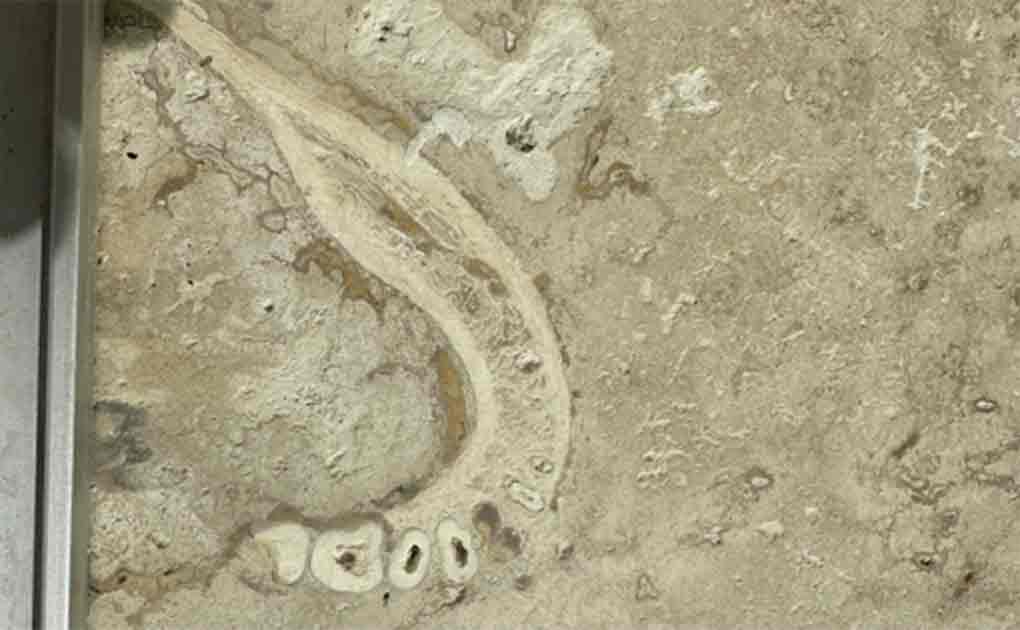Dentist Finds Prehistoric Hominin Jawbone in Bathroom Tile!
During a visit to his parents' recently renovated European home, a man made an unexpected discovery within one of the floor tiles. Upon closer examination, he identified the object as part of a prehistoric human jawbone, complete with a few intact teeth, 4-5 in number. It probably belonged to either a modern human (Homo sapiens) or, more likely, an extinct hominin like Homo erectus or a Neanderthal, placing it anywhere between 24,000 years and 1.9 million years old!
Being a dentist himself, the Reddit user was able to recognize the bone, a detail he shared in a post on the micro-blogging site. This exciting but puzzling discovery clearly alludes to the fact that a tile in his parent’s house contained a rare hominin fossil! Though it is too early to date the find, or which hominin it belonged to, signs point to something older than modern humans, reports The Atlantic.
Traversing Travertine: A Fascinating Limestone
The jawbone was found embedded within a travertine tile; a type of limestone typically formed near hot springs. This particular tile originated from a quarry in the Denizli Basin of western Turkey, where the travertine was deposited between 0.7 million and 1.8 million years ago. This age indicates that the mandible did not belong to a recent individual.
- Teeth Discovered in China Show that Modern Humans Left Africa at Least 30,000 Years Earlier than Previously Thought
- The Teeth Have It: Tracing the Denisovan Legacy Around the World

The photo of the tile containing hominin teeth, as posted on Reddit. (Kidipadeli75/Reddit)
The mandible was situated in a hallway leading to the terrace of the house and seemed to have been intentionally cut at an angle, reminiscent of the CT scans he routinely reviews in his professional capacity.
Travertine, a type of limestone, forms near natural springs where lime-rich bedrock interacts with spring water containing a high concentration of dissolved calcium carbonate. When this water evaporates or cools, particularly around hot springs, the calcium carbonate precipitates as rock, often resulting in substantial deposits around the spring.
It often develops in layers, contributing to the distinctive appearance of travertine tiles. These layers have the capacity to trap various objects, including leaves, feathers, and deceased animals. It is known for its intriguing internal texture when polished, travertine frequently features color bands and calcite crystal inclusions, making it a popular choice for decorative flooring and wall coverings, writes paleoanthropologist John Hawks from the University of Wisconsin-Madison on his blog.
In addition to its aesthetic appeal, travertine commonly contains fossils. These fossils range from algae, plants, and small animals like mollusks and crustaceans, all of which inhabit the spring water. Larger animals, including humans, have also been discovered within travertine deposits. Many notable hominin fossil findings have occurred in such formations, often through quarrying activities for construction purposes.
- Humans Were Mummified into Honey Candy in Arabian Medical Practice
- Bronze Age Bull Geoglyph Found In Siberia Is A First
One such example is the Steinrinne site, situated on a terrace of the Wipper River near Bilzingsleben, Germany. This site has been quarried since the Middle Ages and into the twentieth century. Naturalists began noticing fossils there in the nineteenth century, revealing a wealth of remains including straight-tusked elephants, woolly rhinos, and macaques. These fossils date back to an interglacial period estimated to have occurred between 470,000 and 280,000 years ago.
Archaeological discoveries at the Steinrinne site have been spearheaded by Dietrich Mania since 1969. Excavations have unearthed stone tools and numerous animal bones bearing cut marks from ancient humans, indicating butchering activities. Even stone hand axes crafted from elephant bone have been found, shedding light on the resourcefulness and adaptability of early human populations.
Andrew Leier, a geologist at the University of South Carolina and chair of the Geological Society of America’s sedimentary geology division, commented to Architectural Digest's Katherine McLaughlin that the recent discovery of the jawbone falls "somewhere between uncommon and common" due to the nature of travertine formation.

Remains of a forest rhino (Stephanorhinus kirchbergiensis) dating back 400,000 years, from Bilzingsleben. Museum for Prehistory in Thuringia. (Wolfgang Sauber/CC BY-SA 4.0)
Harboring Fossils and History: A Treasure Trove
Travertine tiles often harbor fossils, as seen in places like the Getty Center in Los Angeles, where feathers, algae, bacteria, animal footprints, and leaves are among the treasures embedded within the stone.
Following the anonymous dentist's post about the discovery, an international team of researchers has reached out to him. Together, they are devising a plan to extract the tile for further examination. Discussions have also commenced with the tile company to explore the possibility of finding additional remains in other pieces of travertine sourced from the same quarry.
Despite being unable to ascertain the age or species of the jawbone from the photograph alone, scientists are optimistic about uncovering this information through further analysis. They intend to subject the specimen to CT scanning to construct a 3D model, while chemical analysis of the rock could provide insights into its age. Tooth enamel samples may offer clues regarding the diet of the jawbone's owner, and there's even a possibility of retrieving ancient DNA.
Remarkably, even from the photograph, scientists have gleaned one intriguing detail: indications suggest that the individual may have undergone dental procedures.
The question arises: why was the jawbone not noticed in the travertine at any point before or during installation? John Hawks delves into this inquiry: he explains that quarry workers typically make rough cuts of travertine to form large panels, during which they inspect for significant defects and gaps before proceeding to polish the stone. Once polished, the tiles are stacked for shipping, and the process moves swiftly, potentially leading to oversights regarding embedded fossils or other anomalies within the stone.
“Small defects and inclusions are the reason why people want travertine in the first place, so they don’t merit special attention,” Hawks concludes. “Consumers who buy travertine usually browse samples in a showroom to choose the type of rock, and they don’t see the actual panels or tile until installation.”
Top image: Close up of the prehistoric jawbone containing hominin teeth in the tile, as posted on Reddit. Source: Kidipadeli75/Reddit
By Sahir Pandey
References
Hawks, J. 2024. How many bathrooms have Neanderthals in the tile? Available at: https://johnhawks.net/weblog/how-many-bathrooms-have-neandertals-in-the-tile/.
Johnson, C.Y. 2024. A dentist found an ancient human jawbone embedded in his parents’ tile floor. Available at: https://washingtonpost.com/science/2024/04/23/human-jawbone-floor-tile-fossil//.
Kuta, S. 2024. Dentist Discovers Human-Like Jawbone and Teeth in a Floor Tile at His Parents’ Home. Available at: https://www.smithsonianmag.com/smart-news/dentist-discovers-human-like-jawbone-and-teeth-in-a-floor-tile-at-his-parents-home-180984210/.
Zhang, S. 2024. A Dentist Found a Jawbone in a Floor Tile. Available at: https://www.theatlantic.com/science/archive/2024/04/hominin-jawbone-fossil-floor-tile-travertine/678153/.
















